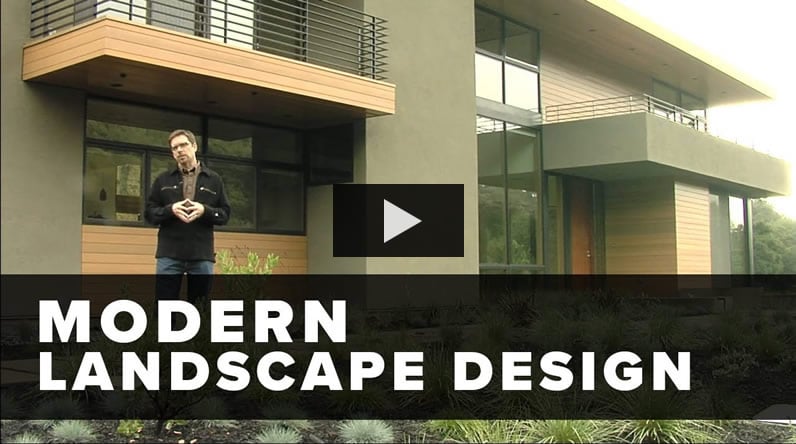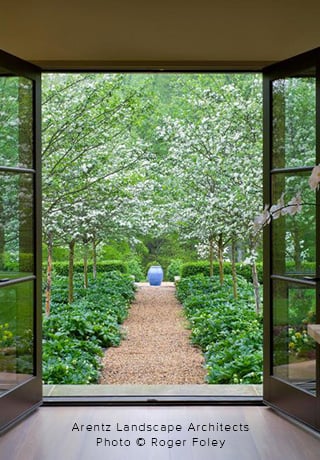Modern Garden Ideas: Create a Contemporary Look in Your Garden
Update your landscape with a chic, fresh look by using these modern garden design ideasCreating a landscape that complements your home is the hallmark of any good garden design. An informal cottage garden pairs well with a bungalow or ranch style home, while a more formal European style landscape complements a Colonial or Tudor house. Modern or contemporary garden design is characterized by a sleek appearance, strong clean lines, and minimalist plantings, achieving a harmonic balance between natural and manmade elements.
Modern garden style is at once functional and visually appealing, with a seamless indoor-outdoor flow that makes the yard an extension of the home. A modern landscape is simplistic and uncluttered, augmenting the home’s exterior without detracting from it. The focus is on structure and form, with the goal of creating a space that’s sophisticated, functional and inviting.
Whether you have a compact urban lot or sprawling suburban property, you can create a modern landscape that is suited to your own needs and personal tastes. Learn more about the principles of modern garden design, and how to incorporate some of these modern garden ideas in your own yard.
On this page:
- WHAT IS A MODERN STYLE LANDSCAPE?
- DESIGN PRINCIPLES OF MODERN GARDENS
- BASIC ELEMENTS OF A MODERN GARDEN
- HOW TO MAKE A MODERN GARDEN
- HOW TO MAINTAIN A MODERN GARDEN
- MODERN GARDEN DESIGN INSPIRATION
- POPULAR MODERN GARDEN ARTICLES
WHAT IS A MODERN STYLE LANDSCAPE?
Modern garden design is a blend of traditional formal European style and modern aesthetics that emerged in the 20th century. The yard is regarded as an extension of the home, with elements that are used to unify indoor and outdoor spaces. The emphasis is on functionality, simplicity, and visual appeal. Outdoor spaces that are beautiful and comfortable encourage more time spent outside, enhancing overall health and well-being while fostering a deeper connection with nature.
The modern aesthetic is disciplined and chic, utilizing clean lines, symmetry, geometric shapes, repetition, and a subdued color palette that doesn’t distract. Modern design features low-maintenance landscaping, with an emphasis on sustainability.
DESIGN PRINCIPLES OF MODERN GARDENS
Modern garden design style is based on a set of principles and striking a balance for the desired effect. These principles include:
Simplicity and minimalism: Hardscape, structures, and plants are used sparingly for a formal, uncluttered look. Every element is intentional, serving a purpose while maintaining a sense of order. Structure, texture, and form are emphasized over color.
Clean lines: Straight vertical and horizontal lines are more orderly and formal looking than irregular curves, emphasizing the simplicity of the design.
Geometric shapes: Elements with distinct geometrical shapes help establish a sense of order. Rounded shrubs emphasize a curved window or alcove, while square or rectangular pavers echo the angular shape of a patio, raised beds, or garden borders.
Repetition: Elements are repeated throughout the landscape to create unity. Use the same materials for pathways; a few key sculptural plants such as boxwood or agave; and structures such as a pergola or arbor in the same style, materials and colors.
Symmetry and balance: A modern landscape uses symmetry to establish balance and a sense of order. Elements arranged in a symmetrical format may include hedging on both sides of a pathway, or flanking an entryway with identical planters. Repetition and focal points reinforce these principles.
Color: Modern landscapes rely on a subdued color palette to reinforce the minimalist look and instill a sense of calm. Neutral tones of grey, brown, tan, white, or black can be combined with cool shades of green and blue that echo natural elements of plants and the sky. Black and white is a classic modern garden color scheme, with dramatic contrast that keeps the design fresh and sleek. A pop of bold color here and there draws the eye and adds an element of surprise.
BASIC ELEMENTS OF A MODERN GARDEN
The emphasis in modern landscape design is on hardscape and structures. Outdoor living areas and pathways are the predominant features, with plants assuming a secondary role. Concrete and steel elements along with glass create a contemporary look, while organic elements of wood, stone, and plants offer contrast. Modern style gardens utilize some or all of the following elements:
Patios, terraces, and decks: These are the primary features for dining, entertaining, relaxing, and playing. Keep these elements simple, using concrete slabs or larger stone pavers for patios and terraces, and wood or composite for decks.
Pathways: Sidewalks and pathways are key elements, connecting outdoor spaces and establishing flow. Use durable and clean-looking materials such as concrete, gravel, or larger pavers. Arrange paths in straight lines rather than irregular curves to retain a formal, orderly look. Paths should be wide enough for comfortable strolling.
Garden beds: Plants are used more sparingly in modern garden design. Limit the amount of garden beds and choose a few key plants with architectural structure and year-round interest that are also low maintenance. Structured planting beds repeated throughout the design provide repetition and unity.
Walls: Walls in various heights establish structure and order. They can be used to provide privacy, as a backdrop, seating area, for vertical living walls, terracing a slope, or to define raised beds and planters. Materials typically include concrete, stucco, or stacked stone for a clean contemporary appearance.
Fences: Fencing can be used to provide privacy, divide garden areas, or as a backdrop to other garden elements. Horizontal fence boards offer a more contemporary feel. Use composite, metal, or wood materials in neutral tones for a chic look.
Structures: Pergolas, arbors, shade sails, and umbrellas add vertical height, providing shade and protection from wind and rain. Trellises are useful for growing plants vertically in a courtyard, for a living wall, or where space is limited. Keep structures simple for a clean, contemporary look.
Pavers: Use larger square or rectangular pavers for patios, terraces, and pathways to keep the design uncluttered. Allow space between pavers to accentuate the shapes.
Gravel and rock: Gravel, river rock, or crushed stone can be used between pavers, as edging, or decorative accents. Finer stone materials such as gravel, crushed rock, or decomposed granite are suitable as primary materials for pathways and gravel gardens.
Containers: Decorative pots can serve as focal points, to showcase plants in a limited space, or on a patio or deck. Choose a few larger pots rather than a lot of smaller containers for an uncluttered appearance. Containers with angular shapes reinforce the clean, straight lines of hardscape and structures. Place pots judiciously as focal points for greater visual impact. Where space is limited, use hooks to hang pots along a living wall, porch, or balcony. The best modern container plants include evergreens or varieties with multi-seasonal traits for year-round appeal.
Water features: Water is a common theme in modern garden design, with fountains, waterfalls, or pools serving as focal points, providing the sound of soothing water, and attracting wildlife. Modern water features are sleek in design, utilizing metal, stone, and concrete materials. Ponds, swimming pools, and reflecting pools are typically square or rectangular for a clean, formal look.
Furnishings and accessories: Choose furniture that is designed for function and comfort, made with durable materials in subdued neutral tones. Outdoor rugs add a splash of color. Statuary and sculptures with an abstract or contemporary look can serve as strategic focal points. A fire pit provides warmth and ambience on cooler nights. Use smaller accents such as a bowl, lantern, or tabletop planter for a finishing touch.
Lighting: Utilize lighting for safety, and to extend time outdoors in the evenings. Choose subdued lighting that is bright enough for safety, but not overwhelming. LED strip lights or small spotlights placed along a pathway emphasize clean, geometric lines. String lights can be used to highlight a fence, pergola, or deck for a festive touch. Modern lighting design typically includes spotlights or up-lights that draw attention to statement trees, statuary, and water features. Choose fixtures with a chic modern aesthetic.
Plants: Selection of plants is as much about function as aesthetic beauty. Plants can provide a privacy barrier, shade, architectural structure, or serve as a stunning focal point to draw the eye. Structure, texture, and foliage contrast are more essential than flowers. Plant varieties for modern landscapes are tolerant of different growing conditions, requiring less maintenance such as pruning and fertilizing.
Architectural plants may include drought-tolerant succulents and cacti, or evergreen shrubs such as boxwood and yew that are clipped into formal shapes. Choose varieties that perform well in your climate, and reflect the local vernacular. Include trees, shrubs, and perennials in different sizes, shapes, and colors to create depth and visual interest. A finely textured ornamental grass combined with a boldly structured plant such as agave or yucca provides compelling contrast.
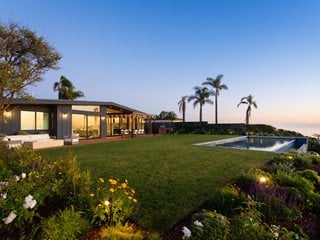
Designer: Ryan and Kate Gross (Kate Anne Designs). Photo by:
Alex Zarour / Virtually Here Studios. See more of this garden.
HOW TO MAKE A MODERN GARDEN
Creating a garden is a unique and personal experience. There is no right or wrong way to design and build the modern landscape of your dreams. You can choose to revamp your entire yard, or just one area. Renovations can occur all at once, or in stages as budget and time allow. Here are things to consider when creating your own modern style landscape:
Choose a site: Evaluate your yard for size, existing structures, soil conditions, and terrain. Observe how the light falls at different times of the year, which will help determine plant selection. Think about how you want to use your yard, whether for dining, lounging, entertaining, or quiet meditation. A modern backyard can include spaces for different functions, while a modern front yard makes a first impression with a welcoming entrance to your home.
Make a list of features you want to include such as a seating area, water feature, fire pit, dining area, or a quiet space for relaxation. A cooking or dining area should be located near the house for easy access, while a quiet seating area can be placed in a more secluded spot.
Get inspiration: There are many contemporary outdoor public spaces and private gardens. Visit modern outdoor spaces in your area. Peruse books and online sources for ideas and inspiration.
Draw a design: Make a rough sketch to help visualize the end result. For more elaborate plans, consult with a landscape designer that specializes in modern garden design.
Consider scale: Materials selection will depend in part on the size of your home and property. Large pavers may be out of scale in a small entryway, while dwarf plant varieties would get lost in a spacious garden border. A tabletop fountain or basin is more suited to a small yard, while a pond or swimming pool would fit on a larger property. When choosing plants, allow enough space for plants to reach their full mature size.
Source local materials: To retain a sense of regionality, use locally sourced stone, gravel and other materials when possible.
Consider year-round interest: A well-designed modern garden will look good in all seasons. Choose durable materials that will endure in your climate, particularly freeze-thaw cycles. Include plants with multi-seasonal interest.
Keep it simple: When it comes to modern design, less is more. Keep outdoor spaces simple to retain a sense of order and tranquility. This is especially crucial with smaller yards, which can become overwhelmed with too many features.
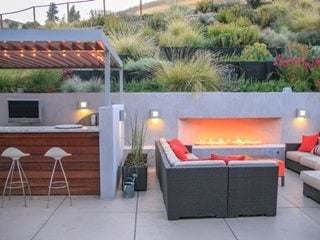
Designer: Colin Miller of Envision Landscape Studio.
Photo by: Colin Miller. See more of this garden.
HOW TO MAINTAIN A MODERN GARDEN
Though modern style landscapes require less maintenance than other types of gardens, they still require regular attention to keep them looking their best.
Keep it clean: Wash down furniture and other features periodically to remove dust and dirt. Power wash concrete sidewalks and pavers that become stained or discolored. Clean out water features periodically to keep water fresh and clean. Pick up leaves, branches, and other debris regularly.
Water: Keep plants watered according to individual needs, and group plants together with similar watering needs. Containerized plants will need more frequent watering than those in the ground.
Prune: Plants will look their best with regular pruning and grooming. Remove broken or diseased branches as they occur, and cut back plants that become overgrown. Shear formal hedging such as boxwood or yew to keep a neat appearance. Deadhead spent flowers.
Weed: Pull weeds regularly to keep garden areas looking fresh. Weeds are more prolific in warmer months of spring and summer.
Sustainability: Use sustainable practices to reduce maintenance and waste. Drip irrigation reduces water evaporation, while mulching around plants suppresses weeds and conserves moisture. Choose drought-tolerant and native plant varieties that require less watering and other maintenance. Include a rain garden to divert stormwater, or capture stormwater for watering plants. Permeable materials such as gravel provide better drainage. Energy saving LED and solar lights require less electricity.
MODERN GARDEN DESIGN INSPIRATION

Decomposed granite flanked by colorful river rock comprises this spacious pathway. Rust-colored corten steel is used for a step and raised planter, accentuating the sleek lines. Lush plantings soften the angular hardscape. Designer: Adriana Berry, Plant Passion Design. Photo by: Janet Loughrey.

A silver ceramic pot planted with agave serves as a chic focal point at the end of a pathway. A metal screen stops the eye while allowing viewers to see further into the garden for a sense of intrigue. Designer: Adriana Berry, Plant Passion Design. Photo: Janet Loughrey.

Square pavers and tall, sleek planters are repeated, emphasizing the angular shape of the stacked stone wall in this inviting narrow space. Designer: Adriana Berry, Plant Passion Design. Photo: Janet Loughrey.

A variety of paving materials create visual interest, drawing the eye through the landscape. Irregular stacked stones comprise a waterfall for a unique contemporary look. Low-maintenance Japanese maples, ornamental grasses, and ground covers offer contrasting shapes, textures and colors for a captivating effect. Designers: David P. Best and Barbara Hilty. Photo: Janet Loughrey.

A spacious pathway leading from the home to an outdoor dining area was constructed in sharp diagonal lines for a visually dynamic effect. Hardscape elements in soft beige and gray tones combine for a sophisticated, contemporary look. Designers: David P. Best and Barbara Hilty. Photo: Janet Loughrey.

Visitors are greeted by different types of lighting at the entrance to this home. The sidewalk is illuminated for safety, while spotlights and uplights highlight a water feature, rain chain and tree. Designers: David P. Best and Barbara Hilty. Photo: Janet Loughrey.

A contemporary dining set adorned with an abstract glass sculpture is the centerpiece of this urban backyard sanctuary. Stucco walls and wooden fencing in subdued earth tones create privacy, while a custom made metal gate accentuates the modern look. Owner: Linda Ernst. Designer: Laura Crockett. Photo: Janet Loughrey.

This narrow sloping yard was terraced with soft beige-pink stucco walls, with an angular pathway that leads the eye to the hilltop view. Accents including a brightly colored ceramic pot, metal chairs, and a round water bowl serve as focal points and give places for the eye to stop. Designer: Laura Crockett. Photo: Janet Loughrey.

The sleek entryway to this modern style home uses different materials of flagstone, stucco and wood for a natural but contemporary look. Slatted wood screens provide structure, height and a sense of privacy. Designer: Laura Crockett. Photo: Janet Loughrey.

Contemporary elements in this sloped urban yard include stucco and stacked stone walls, flagstone pavers, and fencing for privacy. Features including an arbor, waterfall, fire pit, pots, and abstract sculpture have a modern minimalist look. A red lounger adds a bright pop of color. Designer: Lori Scott. Photo: Janet Loughrey.
POPULAR MODERN GARDEN ARTICLES
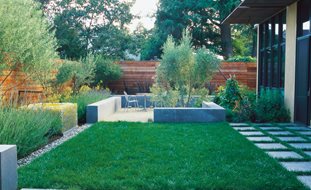
The clean lines of this minimalist garden in Palo Alto, Calif. reveal that less is more.
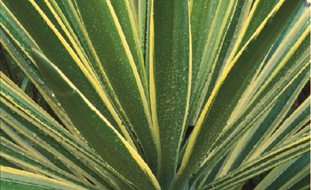
Get modern plant recommendations that will perfectly complement your modern home and garden.

See how the strong geometry of this home is mirrored in the surrounding landscape where city vibe meets Midwest charm.
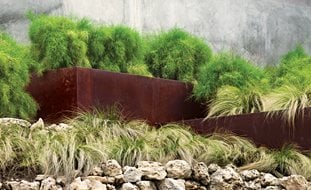
A dramatically tiered, lushly green outdoor space surrounds a modern home of stone and glass.

A dilapidated backyard overlooking the Malibu Bluffs is transformed into a beautiful outdoor oasis.

Tips on designing a contemporary landscape that is suited to the welcoming indoor-outdoor lifestyle.
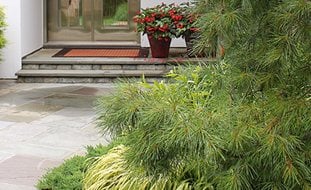
The love for wildlife and a love of gardening can finally come together.
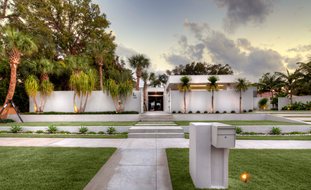
Learn how a distinctive mid-century home is flawlessly restored and improved.
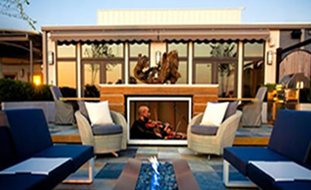
Five considerations for homeowners who would like to transform their rooftop into a luxury outdoor living space.
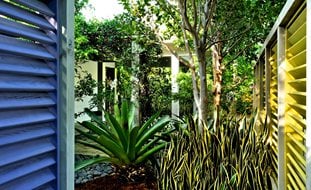
Colorful garden walls and sculptural plants play against a neutral backdrop for a lush, lively take on modernism.
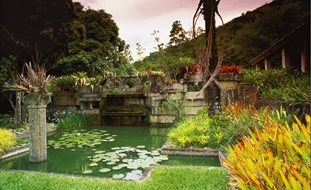
Get a firsthand view of the gardens and public spaces designed by modernist landscape architect Roberto Burle Marx.
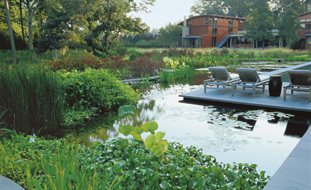
An ecologically friendly Virginia garden sets the groundwork for a new approach to landscapes of enduring beauty.
More on modern gardens:
Sense and Sustainability
Inspiration Point: Philip Johnson's Glass House
Dry Wit: Margaret Joplin's Southwest Hacienda Garden
Prairie Modern: A House and Garden in Fargo, North Dakota
Modern Lines
Holiday Classic Décor Elements Made Modern
Best Gardens: Modern Shaker Design in Westport, Connecticut
Open Invitation: Beverly Hills Glamour
Inventing the Modern Garden: The Miller House and Garden
Midcentury Modernism in Arizona
Spanish Modern
Garrett Eckbo's Midcentury Style
Danish Style
Modern Modes
Mod Must-Haves



